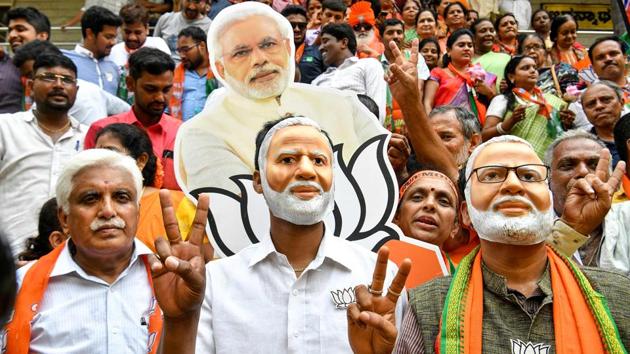How the BJP is increasing its vote share in the South
All the party needs is a strong regional ally or a weakening incumbent to pit itself as an alternative. In the next five years if the BJP focuses on the South like it did over the past decade in the Northeast, could this citadel also fall?
On May 23, standing next to a tea stall I heard a hushed retort, “His name is not Rahul Gandhi. He is Rahul Khan. I am happy he lost.” A man who seemed to be in his mid-30s told the tea vendor, referring to Congress president Rahul Gandhi’s rout in Amethi. We were in Hyderabad, the capital of the youngest South Indian state, Telangana. In the state, the Lok Sabha verdict was composite — the regional party, Telangana Rashtra Samithi, won nine out of 17 Lok Sabha seats, the Congress won three and All Indian Majlis-e-Ittehadul Muslimeen retained its single MP seat in the state. The only surprise that greeted Telangana was the Bharatiya Janata Party (BJP)’s improved performance. And that explained the whispers in tea stalls, the growing number of WhatsApp forwards favouring the party and Hyderabad-based trolls who indiscriminately target anyone criticising the BJP.

In 2019, the BJP in Telangana upped its seat share to four against the one it secured in 2014. The party also improved its vote share from 10.5% to 19%. Most important, it pulled a shocker — the contest in Nizamabad where TRS’s Kalvakuntla Kavitha, incumbent MP and daughter of Chief Minister, K Chandrashekar Rao, lost to the BJP’s D Aravind by a margin of 70,000 votes. A bloc of 176 turmeric farmers who fielded themselves as candidates, thanks to the growing distress in the agriculture sector, killed Kavitha’s chances by polling a total of 98,000 votes. This favoured the BJP, and how. The BJP was able to take on a strong regional party with a vote share of 41.29% (2019) because the electorate considered it a viable alternative even if the endgame was to rout an incumbent MP who failed them during her last term. In the past, that alternative would have been the Congress, which had a formidable presence in Telangana, a part of united Andhra Pradesh before 2014.
While the south largely bucked the national trend by limiting the BJP’s seat share to 29 out of its 128 members of Parliament (MPs), lone trends like that in Telangana suggest that the BJP is a growing presence in the five states located south of Vindhyas. For starters, in three out of five southern states — Karnataka, Telangana and Kerala — the party improved its vote share either marginally or substantially. In Kerala, where the Congress won 15 out of 20 seats, the BJP improved its vote share by 2.48%. Moreover, the Congress’ victory in the state was largely the result of voter dissatisfaction which the BJP engineered to target the Left Democratic Front during the 2018 Sabarimala temple controversy. Topping that, in Karnataka and Telangana, the BJP’s vote share improved by 8.01 and 8.5 percentage points respectively. In Andhra Pradesh, while the party’s seat share dipped by 7.52%, thanks to the YSR Congress Party (YSRCP) wave, which won 22 out of 25 seats, the BJP has not lost favour completely as YSRCP president, Y S Jagan Mohan Reddy, is keen on keeping a distance from the Congress to protect his vote base. Against these state wise performances, it is safe to say that strong resistance to the BJP with a clear mandate against it came from a single state in the South:Tamil Nadu.
In Tamil Nadu, the Dravida Munnetra Kazhakam alliance won 37 out of 38 Lok Sabha seats, because it clearly defined the BJP as an antithesis to Tamil values. The alliance was aware that discontent against the BJP in Tamil Nadu exists not just virtually as suggested by the Twitter trend #GoBackModi. In protest rallies against the Sterlite copper smelter plant in Thoothukudi, in anti-NEET protests and anti-GAIL protests, the common sentiment was resistance to the BJP and its policies, be it the industrial policy, demonetisation or attempts to amend India’s Constitution. The DMK and its alliance partners, including Viduthalai Chiruthaigal Katchi, CPI, CPI (M) and Indian Union Muslim League capitalised on this strong undercurrent of Dravidian discontent towards a Hindu nationalist party which Tamil Nadu’s public sphere, shaped by self-respect movement of Periyar E V Ramaswamy’s rationalist tradition, harbours. But five years from now, if the electoral tide changes in favour of DMK’s rival party, the All India Anna Dravida Munnetra Kazhakam, which is a National Democratic Alliance partner, the BJP may have a hold on the state albeit a proxy one.
South India, with its history of social justice, anti-caste and communist struggles is slowly losing its edge when it comes to resisting the BJP electorally. All the party needs is a strong regional ally or a weakening incumbent to pit itself as an alternative. In the next five years, if the BJP focuses on the South like it did over the past decade in the Northeast, could this citadel also fall?



